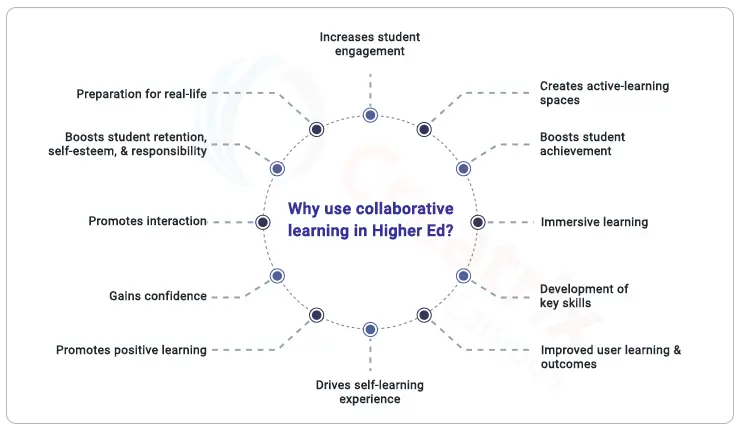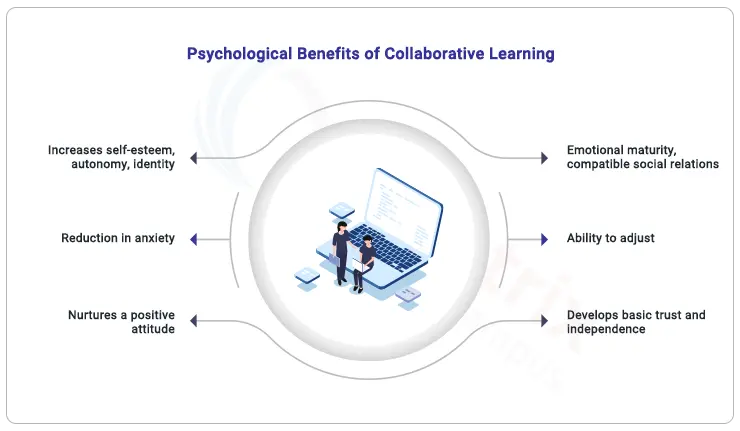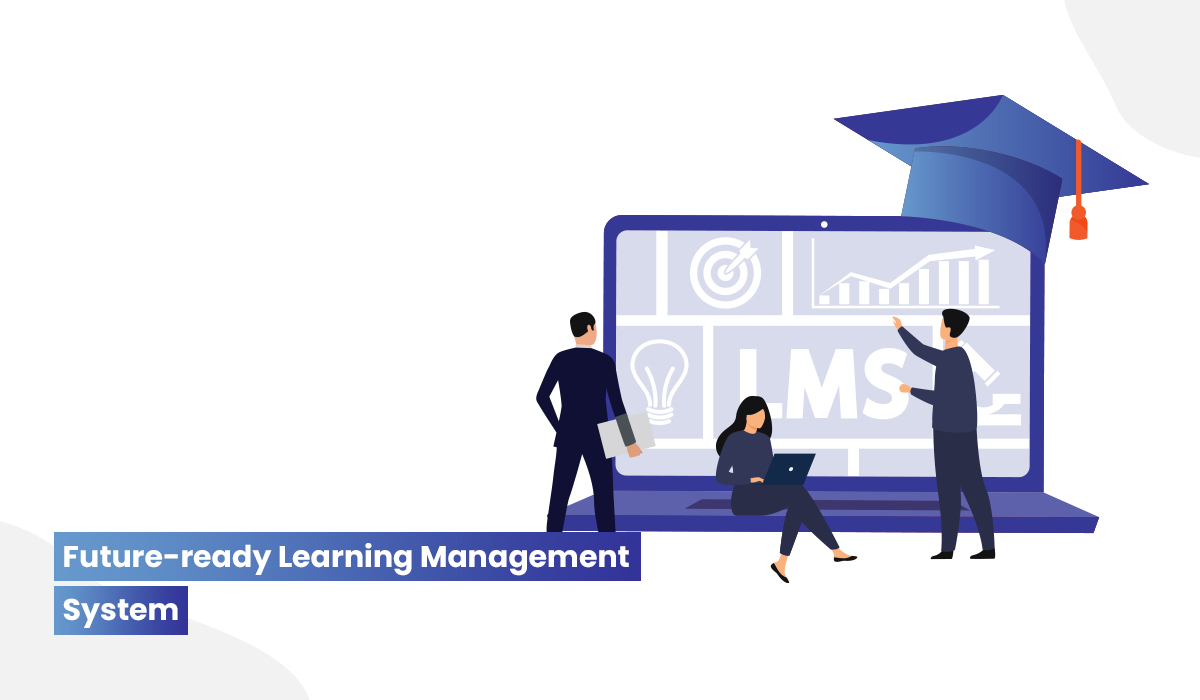What is the need for collaborative learning in higher education?

Introduction
Collaborative Learning in higher education has become a predominant twenty-first century’s learning aid. The current society demands the student community to think and work together on critical issues. This shift in emphasis from individual efforts to group work, from independence to community is achieved through Collaborative Learning.
This has driven the invention of collaborative technology in higher education with more and more classrooms, lecture halls, labs being equipped with cutting-edge software systems to foster collaboration. Let us see why higher education institutions should focus on collaborative learning here.
What is collaborative learning?
Collaborative Learning (CL) is a learning and teaching approach that’s quite prominent in today’s education scenario, which involves learners or cohorts working together to learn, research, solve, create or complete a given task. This is in complete contrast to self-paced learning. While the term self-paced learning is learning by one’s self, the term collaborative learning is often referred to as collaborative, cooperative, or team-based learning.
Why is collaboration important in higher education?
“Learning together is a process”, according to Henry Ford. Collaborative learning is all about that.
Collaborative learning or cooperative learning gives the opportunity for students to engage in the learning process and synthesize concepts rather than just rote learn to pick up facts and figures.
Days like COVID now, students prefer to collaborate with their peers on projects and to understand the concepts. They prefer to reframe ideas, defend their positions, articulate points, and gain better understanding during collaboration.
It is time for higher eds to create the best opportunities for students to collaborate and redesign the curriculum to accommodate a more collaborative and interactive learning environment.
The focus should be on how to build their social-emotional learning skills, and to build communicative abilities to work in a collaborative environment that boosts discussion, interaction, and problem-solving.
This is not challenging anymore. With technology and its virtual advancement, there are more ways to let students collaborate, beyond their classroom.
Why should higher ed focus on collaborative learning?

Increases student engagement
Collaborative learning allows students to connect and communicate with each other in a better way. These days LMS’s come with video conferencing tools that enable students to actively engage in virtual group meetings, seminars, casual collaboration, chats, and discussions even outside the classroom. Students get to work on group projects, study sessions with instructors and peers. Students tend to teach and learn in group work.
Creates active-learning spaces
Collaborative learning or active learning creates active learning spaces for students to question, learn, and probe each other. Given the current situation with more and more distance and remote learning opportunities, collaborative technologies can play a great part in keeping students engaged as like on campus. HD video conferencing can be one such way.
Immersed in interactive technology in their everyday lives, students expect the same types of tools on campus too. Institutions can make use of digital whiteboard tools, on-demand, and pre-planned sessions, application & desktop sharing, to arouse collaboration and to give students an ultra learning experience. This responsive touch technology gives students easy annotation and seamless idea-sharing inside and outside the classroom.
Boosts student achievement and performance
Empirical researches of the past have demonstrated a positive correlation between collaborative learning and student achievement.
Students exhibit effort, persistence, and motivation while learning with their cohorts. It promotes deeper learning and understanding with solid student engagement, high-quality interaction, and discussion. All this ultimately leading to building student performance and progression.
Immersive learning
Completely away from traditional learning, collaborative learning embeds knowledge more profusely than just through listening and sharing. Students get to remember what they learn with a peer than what is simply learned in a classroom. There’s constructivism, team work, and a positive learning environment.
By trying to explore new ideas with new approaches to solve a given task, students gain a deeper level of understanding and memory of key skills.

With collaborative learning, students acquire key critical thinking skills. Peer-to-peer learning with peer review stimulates deeper thinking in them. According to the collaborative theories of the past, learning in cohorts develops higher-order thinking, stimulates better communication, leadership skills, self-management, and organizational skills.
The present-day has a lot of online web-conferencing collaborative tools students come together to learn online, share files, notes, instructive videos, take assessments, know their grades, all in a single go.
This process of new learning allows students to build better rapport with their peers, develop higher-order critical skills, and self-manage their tasks and priorities for better outcomes attainment.
Improved user learning
Students get the privilege of optimizing their learning, just the way they want. Institutions can make the most of the collaborative tools which most of today’s software comes with to meet their institution’s goals. There can be more interactivity tools with rich content in use, video uploads, discussions and polls online, assessments in the form of quizzes, projects, assignments, etc.
Improves the overall classroom outcomes
With the acquisition of critical skills, the student community’s overall classroom attainment is increased. They get motivated to make us learn new topics, beyond their curriculum and love to utilize the various collaborative teaching techniques in their assessments.
Drives self-learning experience
With this model of learning students take complete charge of their learning. Today software tools come with interactive playback options which allow students to even record their past sessions, so they could pause, rewind, or fast-forward lessons, and provide comments to topics.
Promotes positive learning atmosphere psychologically
Collaborative learning establishes a constructive atmosphere with students forming learning communities, allowing them to develop a more positive modeling environment. Some of the physiological benefits students develop are;

Builds confidence
A well-planned collaboration activity in the classroom allows students to realize the importance of their individual contributions. They develop the confidence to learn from their mistakes and to teach each other.
Unlike a traditional classroom, a collaborative environment provokes students to explore by taking up many forms. It includes problem-based learning, a lot of jigsaw activities, peer-review and activities like think-pair-share, which are some of the most common examples of a collaborative learning environment.
Comprehensiveness
No student is average. They get to play their part better with collaborative learning and to move forward. Students have the opportunity to exhibit their innate skills, strengths, which get valued and recognized by their peers in a collaborative setting.
Promotes interaction
For effective learning to happen, there should be constant student-faculty interaction. Traditional learning had the faculty just as an instructor, who diligently did the job of teaching and just teaching. There was a lack of two-way interaction. With online collaborative learning, the scene has transformed with the faculty being a facilitator. Students constantly intercede, interrupt to get their muddy points cleared.
On the other hand, students help, assist, support, encourage, praise each other while in groups. They develop a tolerant behavior when exchanging contrasting opinions and figure out an alternative solving strategy to work on things.
Boosts student retention, self-esteem, and responsibility
According to the famous Lev Vygotsky’s idea of Social Development, learners depend mutually to complete tasks, which are otherwise not so easy to complete individually. By collaborative dialogue, a peer who has better experience or knowledge can influence the other.
During the process, they develop self-esteem and become much more responsible. Higher education institutions can use collaborative learning as a technique to retain students and to balance out student dropouts.
Exposure to and an increase in understanding of diverse perspectives
With specific goals and expectations outlines, students get a clear picture of the goals they are expected to meet as a group and work with full potential to complete the given task.
A mixed collaborative group with a range of backgrounds, talents, ideas, experience, learning styles, ideas, can be the best. Researches have proven that students with mixed aptitude groups prove to learn better. When such students get together to discuss, clarify, and evaluate other’s ideas, the information gained remains in the long-term memory and they get diverse perspectives out of a given situation.
Preparation for real-life social and employment situations
The current social and employment demand is to equip students to deal with real-life situations. This shift in learning is achieved by collaborative thinking. Faculty can place real-world problems before the students and not the imaginary ones. With such practical, real-life assignments, they feel involved in the task and work towards forming real opinions. It could be an environmental issue or a societal issue, creating one such scenario will allow them to challenge and solve it efficiently.
Collaborative learning theory
Though there are various theories behind collaborative learning, it is deep-rooted by the concept that learning by nature is a social act, which involves more of talking, attempting to solve problems, and seeking to understand the world.
1. Lev Vygotsky’s idea of Social Development
Of the many theories that back up collaborative learning theory, the most important one is the one that of Lev Vygotsky’s idea, Zone of Proximal Development. According to this, learners depend mutually to complete tasks, which are otherwise not so easy to complete individually. By collaborative dialogue, a peer who has better experience or knowledge can influence the other.
2. Piaget’s theory of cognitive development
According to this theory of Jean Piaget, infants and children develop an understanding of the world around them and start reasoning out to develop hypotheses. This process keeps growing as the children grow, where they are able to experience discrepancies between their understanding and their experiences, and eventually correct them by reorganizing their mental processes.
Piaget brought in the term ‘schemas’, which are the building blocks or the units of knowledge that lets humans categorize knowledge and understand difficult concepts. According to him, humans have some inherent schemas and the cognitive development of humans is entirely connected to the depth and the number the schemata they possess.
These schemata take two forms as the children grow—assimilation and accommodation. While with assimilation, a child uses the existing schema to handle the new situation/object/interaction, with the accommodation he/she rules out the old schema for new to deal with another new situation/object/interaction. Both processes require an active learner to discover new problem-solving skills.
Piaget presented a four-stage cognitive development process that a human should possess before learning could commence.
- Sensorimotor (from birth - two years)
- Preoperational (two - seven years)
- Concrete Operational stage (seven-eleven years)
- Formal operational stage (beginning of eleven years)
- Kegan’s Cognitive Developmental Theory
While Lev Vygotsky and Kegan’s theories revolve around cognitive development in children and believed that cognitive development ended around the age of 25, Kegan asserted that humans develop the systems continuously which helps to transform the way that they interact with the world.
According to Kagan, growing to be an adult refers to transitioning to higher stages of development, where he develops self-awareness, grows wiser and mature.
The five stages of Kegan’s cognitive development are;
- Impulsive mind - Impulse drove early childhood stage
- Imperial mind - Adolescent stage driven by outside consequences, then internal belief systems.
- Socialized mind - A stage dominated by external sources, regardless of personal desire.
- Self-authoring mind - A stage where an individual self-defines himself, without the interference of external influences.
- Self-transforming mind - A stage where personal autonomy grows where the individual constantly adjusts and reacts to information, experiences, and interactions.



